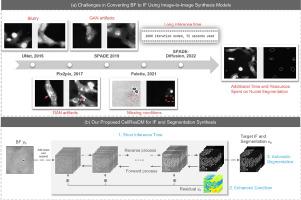Artificial immunofluorescence in a flash: Rapid synthetic imaging from brightfield through residual diffusion
IF 5.5
2区 计算机科学
Q1 COMPUTER SCIENCE, ARTIFICIAL INTELLIGENCE
引用次数: 0
Abstract
Immunofluorescent (IF) imaging is crucial for visualising biomarker expressions, cell morphology and assessing the effects of drug treatments on sub-cellular components. IF imaging needs extra staining process and often requiring cell fixation, therefore it may also introduce artefacts and alter endogenous cell morphology. Some IF stains are expensive or not readily available hence hindering experiments. Recent diffusion models, which synthesise high-fidelity IF images from easy-to-acquire brightfield (BF) images, offer a promising solution but are hindered by training instability and slow inference times due to the noise diffusion process. This paper presents a novel method for the conditional synthesis of IF images directly from BF images along with cell segmentation masks. Our approach employs a Residual Diffusion process that enhances stability and significantly reduces inference time. We performed a critical evaluation against other image-to-image synthesis models, including UNets, GANs, and advanced diffusion models. Our model demonstrates significant improvements in image quality ( in MSE, PSNR, and SSIM), inference speed (26 times faster than competing diffusion models), and accurate segmentation results for both nuclei and cell bodies (0.77 and 0.63 mean IOU for nuclei and cell true positives, respectively). This paper is a substantial advancement in the field, providing robust and efficient tools for cell image analysis.

瞬间人工免疫荧光:从明视野到残余扩散的快速合成成像
免疫荧光(IF)成像对于观察生物标记物的表达、细胞形态以及评估药物治疗对亚细胞成分的影响至关重要。免疫荧光成像需要额外的染色过程,通常需要固定细胞,因此可能会产生伪影并改变内源性细胞形态。有些中频成像染色剂价格昂贵或不易获得,从而阻碍了实验的进行。最新的扩散模型能从易于获取的明视野(BF)图像中合成高保真的中频图像,提供了一种很有前景的解决方案,但由于扩散过程中存在噪声,因此存在训练不稳定和推理时间慢的问题。本文提出了一种新方法,可直接从明场图像和细胞分割掩膜中获得有条件合成的中频图像。我们的方法采用了残差扩散过程,增强了稳定性并显著缩短了推理时间。我们对其他图像到图像合成模型进行了严格评估,包括 UNets、GAN 和高级扩散模型。我们的模型在图像质量(MSE、PSNR 和 SSIM 的 p<0.05)、推理速度(比同类扩散模型快 26 倍)以及细胞核和细胞体的精确分割结果(细胞核和细胞真阳性的平均 IOU 分别为 0.77 和 0.63)方面都有明显改善。本文是该领域的重大进展,为细胞图像分析提供了强大而高效的工具。
本文章由计算机程序翻译,如有差异,请以英文原文为准。
求助全文
约1分钟内获得全文
求助全文
来源期刊

Neurocomputing
工程技术-计算机:人工智能
CiteScore
13.10
自引率
10.00%
发文量
1382
审稿时长
70 days
期刊介绍:
Neurocomputing publishes articles describing recent fundamental contributions in the field of neurocomputing. Neurocomputing theory, practice and applications are the essential topics being covered.
 求助内容:
求助内容: 应助结果提醒方式:
应助结果提醒方式:


